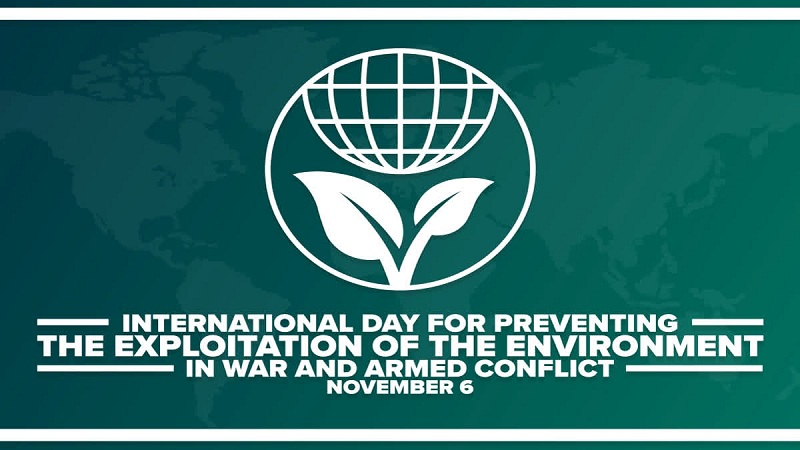Article: Environment a silent casualty of war
 Nissar Ahmed Thakur
Nissar Ahmed Thakur
“Wars and conflicts have many consequences beyond deaths; Conflict often lead to significant harm to the environment, depletion of natural resources, and devastation of habitats”
November 6th is observed as the International Day for Preventing the Exploitation of the Environment in War and Armed Conflict. The day serves as a reminder of the impediments to peace caused by the diminishing natural resources in conflict-ridden areas across the globe. The initiative also emphasizes the need for collaborative efforts involving governments, NGOs, local communities, and individuals to effectively prevent the exploitation of the environment during times of conflict.
Regrettably, the environment continues to be at heightened risk due to the spike in global conflicts, especially in third-world nations. These conflicts, which vary in nature, have resulted in numerous casualties as well as the unprecedented destruction of natural resources. Surge in hostilities in the Middle East, Africa, and Asia, and the resultant fallout on Europe and the US, has highlighted the immediate need to address these conflicts before they evolve into an unprecedented crisis.
Similarly, the conflicts ailing South Asian region today have roots in historical issues dating back to the colonial and pre-colonial periods. The ongoing Kashmir conflict is one of these deadly conflicts that has not only resulted in heightened tensions but an unending arms race between the two nuclear-armed nations-India and Pakistan. The substantial buildup of military forces in the Kashmir region, along with skirmishes between the two armies on the Line of Control and the exchange of artillery fire, has had devastating effects on the region’s environment, public health, and economy.
Experts believe that the decades-long conflict in the Himalayan region has not only harmed human lives but also pushed the region’s fragile environment to the brink of disaster. It’s a natural phenomenon that the environment suffers the most wherever there is human activity, especially in areas identified as eco-fragile zones. Kashmir being one of them faces severe environmental threats. Experts trace environmental degradation in Kashmir back to 1947. A research paper on war and environment in Kashmir notes that the deployment of Indian and Pakistani armies in the Kashmir region in 1947 resulted in the large-scale poaching of endangered species like the ibex, blue sheep, sheep, deer, and snow leopards. However, the Kashmir region had witnessed massive troop deployment since the outset of ongoing resistance movement against India. As reported by the Jammu and Kashmir Civil Society (JKCCS), nearly one million military and paramilitary troops are deployed in the region. The massive presence of armed forces in any eco-fragile region like Kashmir is disastrous for the environment, affecting not just humans but also the region’s flora and fauna.
The presence of sprawling military camps in and around the Kashmir Valley poses significant environmental concerns. The extensive militarization has led to the degradation of glaciers, such as the Machoi and Kolahoi glaciers, which have retreated by 29% and 18%, respectively. The Siachen Glacier, once the world’s second-largest glacier, has receded by 800 meters in just 11 years and 1,700 meters in 17 years due to the military’s presence.
On the other hand, the building of dams and hydroelectric power projects in environmentally sensitive areas of Kashmir by India has caused significant harm to the natural environment. The building of dams has not just changed the original path of rivers, but it has also resulted in a higher likelihood of flooding, extensive cutting down of trees, and land erosion. For example, the Salal Power Project has faced widespread criticism due to its effects on displacement, environmental degradation, and the livelihoods of local communities. The Dul Hasti Hydroelectric Power Project has caused concerns over the deforestation, disturbance of habitats, and pollution of water. The Kishanganga Hydroelectric Power Project was strongly opposed by Pakistan citing concerns about water diversion and potential environmental impacts.
The highly publicized Udhampur-Srinagar-Baramulla Railway Link (USBRL), which was built by India to meet its strategic objectives in the region, is viewed as one of the most wasteful railway projects ever undertaken in the history of India’s railways. The project resulted in the acquisition of vast amounts of agricultural, forest, and orchard land, leading to the loss of jobs for thousands of Kashmiris in the valley whose livelihoods relied on the orchard industry.
Environmental consequences
So far as the environmental consequences of the militarization are concerned, the Indian military’s actions, such as cutting down trees to set up camps, have contributed to deforestation, leading to a 35% decrease in monsoon rainfall and a 10% decrease in snowfall. The use of chemical weapons and pellet guns by Indian forces has released pollutants that settle on glaciers, accelerating their melting. The Indian military’s presence has generated tons of toxic waste, including discarded tools, crashed helicopters, and other hazardous materials, which contaminate the environment. In addition to deforestation, the Military construction and vehicle movement in highly sensitive areas has led to soil erosion, landslides, and sedimentation in water bodies.
Impact on Local Ecosystems
The militarization of Kashmir has disrupted the delicate balance of the region’s ecosystems, threatening the livelihoods of local communities. The degradation of glaciers and deforestation have led to water scarcity, affecting agriculture and food security. A separate study mapped 147 glaciers in Kashmir, revealing a 28.82% decline between 1980 and 2018, significantly higher than other Himalayan regions.
As per a survey, the Indian military’s actions, such as cutting down trees to set up camps, have contributed to deforestation, leading to a 35% decrease in monsoon rainfall and a 10% decrease in snowfall. As per reports the region has lost over 59 square miles of forest cover since 1989, primarily due to timber smuggling and the timber mafia.
Similarly, another survey says that the Himalayan glaciers in Kashmir are receding at an alarming rate, with a glacial volume change of 3.6% to 97% and degradation of 17% to 25%. Pertinently, the Kashmir region is home to several endangered species, including the Musk Deer, which is listed as Endangered on the IUCN Red List.
Military camps and activities in the Kashmir valley have contaminated the valley’s vital water body. Military presence contributes to pollution, encroachment, and siltation in the Dal Lake, once a pristine water body.
The forest cover in Kashmir has dropped by a concerning 35%, while the water flow in River Jhelum has also decreased by 40%. The significant rise in air pollution by 25% in Srinagar city, along with a 30% decline in biodiversity in the Kashmir Himalayas, indicates the severe environmental risks present in the area.
Impact on Human Health
Significant rise in air pollution has exacerbated respiratory issues and contaminated water causing water-borne diseases including gastroenteritis, diarrhea, and other illnesses. The environmental degradation and conflict-related stress has been adversely affecting the mental well-being of the indigenous population.
The environmental degradation in the region underscores the need for an urgent action, involving influential world governments, organizations, and local communities, to protect the region’s natural resources, promote sustainable development, and address the environmental consequences of conflict.
Although India has pledged its support for environmental protection, but, it has been criminally negligent in addressing environmental concerns and threats to human life, flora, and fauna in Kashmir.
The International Day for Preventing the Exploitation of the Environment in War and Armed Conflict is observed globally on 6th November with a strong emphasis on the effective monitoring, collection, sharing, and evaluation of information concerning potential environmental impacts. Unfortunately, there is a lack of sufficient focus on tackling conflicts that present a grave danger to the environment.
Amidst the alarming rise in conflicts, an effective conflict resolution mechanism is direly needed to save the environment from hazards of wars and conflicts. Wars and Conflicts have many consequences beyond deaths. Conflict often leads to significant harm to the environment, depletion of resources, and devastation of habitats.
Settling conflicts peacefully can be instrumental in safeguarding the environment and maintaining the balance of ecosystems. By prioritizing conflict resolution and environmental protection, we can not only attain Sustainable Development Goals (SDGs) but also pave a way for long-lasting peace, stability, and the well-being of people across the globe.
Writer is Director media communications at Kashmir Institute of International Relations and can be reached at : nissarthakur@gmail.com








